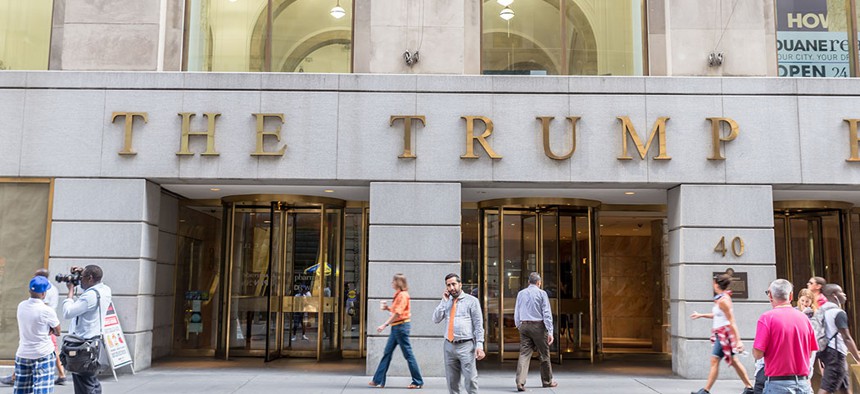New York City
Trump’s tax documents show major discrepancies
The president’s company inflated profit expectations in documents filed to loan lenders – but lowered numbers in documents filed to NYC tax authorities.

The Trump Building, located at 40 Wall Street. Alexander Prokopenko/Shutterstock
A new report published by ProPublica on Wednesday reveals major discrepancies between what President Donald Trump’s company, the Trump Organization, reported to New York City tax authorities and what it reported to commercial loan lenders.
In tax and loan documents, obtained by ProPublica, it appears the Trump Organization inflated expenses and profit projections to make its real estate properties look more profitable to lenders, simultaneously providing tax authorities – responsible for setting the property tax rates for the organization’s properties – with lower numbers. It was also discovered that the company challenged its property taxes nine years in a row, in an attempt to lower its property tax rates.
During Michael Cohen’s congressional testimony before the House Oversight Committee in February, the president’s former fixer alleged that Trump inflated and deflated his organization’s financial numbers for personal and financial gain, making ProPublica’s report all the more valuable. “It was my experience that Mr. Trump inflated his total assets when it served his purposes, such as trying to be listed amongst the wealthiest people in Forbes, and deflated his assets to reduce his real estate taxes,” Cohen told the House committee.
Numerous discrepancies were found among the documents submitted to New York City tax authorities and lenders, reviewed by ProPublica, for the Trump Organization’s properties including: 40 Wall Street, the Trump International Hotel and Tower, 1290 Avenue of the Americas and Trump Tower. But the most glaring discrepancies were found in documents pertaining to the 40 Wall Street and the Trump International Hotel and Tower properties.
The 40 Wall Street property told its lender Ladder Capital in 2012, that the building’s occupancy was rising rapidly, following a slump in leasing post-9/11. Documents submitted to city tax officials did not show any apparent growth in leasing, though representatives for the Trump Organization told lenders that the building’s occupancy was at 81% in 2012. Between 2013 and 2015, there was a 10 percentage point gap between documents submitted to tax authorities and lenders, until 2016 when the numbers reported by the Trump Organization began to align.
The reported rise in occupancy and projections that the property’s profits would soar were key to the organization’s refinancing of the property, according to ProPublica. Ladder Capital loan underwriters predicted 40 Wall Street’s profits would more than double after 2015, resulting in over $22.6 million per year in net operating income. The Trump Organization also got credit ratings companies Moody’s and Fitch to sign off on its projections, which enabled the organization to secure a loan with good ratings – facilitating appealing to prospective investors by packaging the loan as a bond. The organization ended up with a 10-year loan that came with a lower interest rate than what the building originally had, allowing Trump to defer paying off the loan’s principal until the end of its term.
The organization’s loan ended up being put on the loan servicer’s “watchlist,” a year after the loan was issued, for three months, over concerns that payments would not be made since profits were low. The 40 Wall Street property never met Ladder Capital underwriters’ profit expectations – something that financial experts conveyed to ProPublica was quite unusual – and the Trump Organization is still paying off its loan, which is currently $157,400,000 in debt.
The organization's financial records from 2018, reveal that the building’s property insurance was listed as $744,521 on documents submitted to tax authorities, while the expense was listed as $457,414 in documents submitted to lenders. More puzzling, the Trump Organization doesn’t even own the 40 Wall Street property, it merely pays a wealthy German family for the rights to lease the building’s units according to ProPublica. In a document submitted to tax authorities, it was reported that the organization pays $1.65 million for the right to lease the building’s units, but reported spending $1.24 million to loan servicers.
The Trump International Hotel and Tower, is similarly not owned by the Trump Organization, though they do retain two commercial spaces and a parking garage which are leased to commercial vendors. In 2017, the organization reported reaping $822,000 from renting out the commercial spaces, but told loan servicers $1.67 million was earned. The organization only reported to tax authorities about 81% of what was reported to lenders. It also omitted profits made from renting the building’s rooftop on tax documents, even though the organization doesn’t own the rooftop, profits made should have been reported on tax appeals forms, experts told ProPublica.
This is not the first time an investigative report has suggested that Trump has cheated on his taxes. As The New York Times revealed a year ago, Trump, his father, his siblings and his company have been engaged in questionable and possibly illegal practices for decades.

NEXT STORY: Ritchie Torres outraises the field in South Bronx congressional race